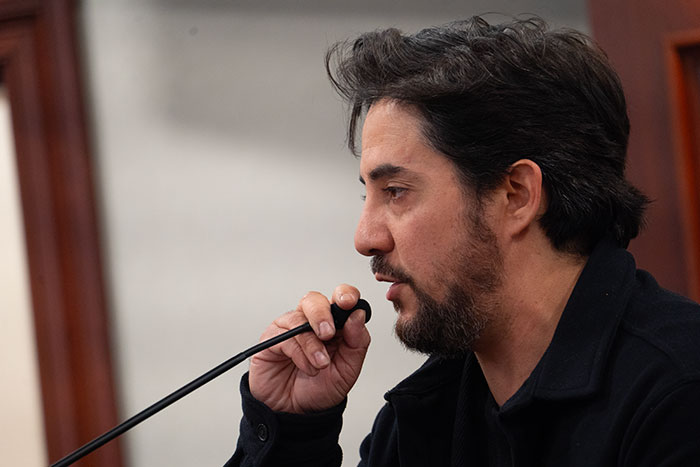Cell tower design denied after residents protest
The architectural commission on Wednesday denied plans for a cell phone tower in south Claremont that would have been disguised as a church steeple.
The 63-foot tower, commissioned by SmartLink Wireless on behalf of Verizon, would be placed at the Claremont Center for Spiritual Living on South College Avenue. Nearly 20 residents spoke out against the project, claiming the tower was too imposing for the area and citing health and property value concerns.
The trapezoidal tower would be placed in front of the main building in a grassy area in front of a parking lot fronting College Avenue. The top of the stucco-coated tower would have “an embossed star-burst image that corresponds to the Center for Spiritual Living visual motif,” the city said.
Inside the tower would be 12 panel antennas, 12 remote radio units, two dual-mount brackets and one microwave dish.
“The goal here is to not see any of the wireless equipment,” Claremont associate planner Nikola Hlady said in his presentation to the commission.
This isn’t the first cell phone tower built in Claremont that is disguised as a church steeple. Saint Ambrose Episcopal Church built one in 2018 amid protests from some nearby residents. It was also a Verizon tower.
Residents nearby came out in droves against the proposed tower.
Murray Wentz, who lives in the adjacent College Oaks townhomes, was concerned about health issues and the prospect of the tower putting a dent in his property value. He also said the tower would be an eyesore from his balcony.
“Right now I see the top of the mountains and the beautiful trees of Claremont, and now I’m going to see this,” Mr. Wentz said. “I would have never, never purchased my home if that was sitting there, and I’m sure there’s going to be nobody purchasing my home when they walk out on their balcony and see that.”
Others wondered why the community surrounding the tower wasn’t properly informed when the plans were in the initial stages, and some took issue with the idea of a corporation seemingly taking advantage of a local church.
“I feel for a struggling church, but you can’t sell out the neighbors, you can’t sell your residents for something like this that’s going to impact us,” resident Kim George said.
At times, the meeting became testy. One resident argued with architectural commission chair Mark Schoeman and Principal Planner Chris Veirs. Some residents occasionally spoke out of turn from the audience.
One resident called the proposed tower “phallic” and another compared it to the former Tower of Terror ride at Disney’s California Adventure.
Rev. Tracy Earlywine, Claremont Center for Spiritual Living’s minister, said the church was not “in this for the money,” but noted the money from the tower’s construction would pay for much-needed improvements such as a new roof, new air conditioning, new parking lots and better lighting systems.
She emphasized the church did not want to create a barrier between it and the community.
“If they use our property, it would be lovely. If it doesn’t work out, it doesn’t work out,” Rev. Earlywine said. “But we’re not here to push people away. We are a spiritual community committed to living in harmony, and that’s who we are.”
Some residents insinuated the city might have been working with Verizon to place the tower at the church, possibly for financial gain. Mr. Veirs said the city does not get “direct payment” for adding telecommunication facilities and it isn’t telling wireless companies where to put their towers.
“We don’t have any skin in the game in terms of trying to pick sites for any locations. We react to their recommendations,” Mr. Veirs said.
Some of the concerns from residents were not part of the commission’s purview. The commission did find, however, that the tower itself was not compatible with a few architectural design standards, including the critical finding it wasn’t compatible with the surrounding neighborhood.
Mr. Schoeman said that while he likes large and simple structures like this one, it wasn’t compatible with a small church. That alone turns the church into “something dominated by its own tower.”
“I just think it’s poor design,” he added. “You can compass that next to the view from the south, that’s poor design in someone’s face, and that’s detrimental to the convenience of those people.”
Commissioner John Neiuber noted that while churches are good places to disguise cell phone towers, typically those churches are 40-50 feet high themselves, which lessens the overall impact of the tower. That was not the case in this instance.
In addressing concerns from neighbors of not being notified during the initial stages of the project, Mr. Neiuber said while there wasn’t a code requirement, “This is Claremont. You engage the community here.”
The commission unanimously denied the tower’s design, 6-0. Commissioner Waen Messner was absent.
Community Development Director Brad Johnson said the city intends to bring a resolution denying the project to the next architectural commission meeting.
“It sounded to me like the neighbors were dissatisfied with the design of the tower entirely and fairly opposed to the location on the property,” Mr. Johnson said.
But that does not mean the tower itself is done. Some alternatives Mr. Johnson mentioned were redesigning the aesthetics of the tower, relocating it to a different area of the property where neighbors feel less impacted, or looking for other sites in or near the neighborhood to fill any coverage gaps Verizon finds.
—Matthew Bramlett
news@claremont-courier.com










0 Comments